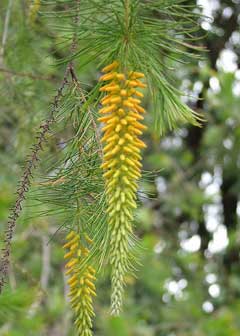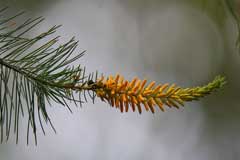 |
|
http://en.wikipedia.org/wiki/User:Melburnian |
 |
| www.flickr.com/photos/marj_k |
Translate this page:
Summary
Physical Characteristics

 Persoonia pinifolia is an evergreen Shrub growing to 3.5 m (11ft 6in).
Persoonia pinifolia is an evergreen Shrub growing to 3.5 m (11ft 6in).
See above for USDA hardiness. It is hardy to UK zone 9. It is in leaf all year, in flower from July to August. The species is hermaphrodite (has both male and female organs).
Suitable for: light (sandy) and medium (loamy) soils, prefers well-drained soil and can grow in nutritionally poor soil. Suitable pH: mildly acid and neutral soils. It cannot grow in the shade. It prefers dry or moist soil. The plant can tolerate maritime exposure.
UK Hardiness Map
US Hardiness Map
Synonyms
Plant Habitats
Woodland Garden Sunny Edge;
Edible Uses
Edible Parts: Fruit
Edible Uses:
Fruit - raw or cooked. Succulent but astringent[157]. The fruit has a sweet fibrous pulp that is fixed to one large seed, it tastes somewhat like sweet cotton wool and is relished by the Australian Aborigines[193].
References More on Edible Uses
Medicinal Uses
Plants For A Future can not take any responsibility for any adverse effects from the use of plants. Always seek advice from a professional before using a plant medicinally.
None known
References More on Medicinal Uses
The Bookshop: Edible Plant Books
Our Latest books on Perennial Plants For Food Forests and Permaculture Gardens in paperback or digital formats.

Edible Tropical Plants
Food Forest Plants for Hotter Conditions: 250+ Plants For Tropical Food Forests & Permaculture Gardens.
More

Edible Temperate Plants
Plants for Your Food Forest: 500 Plants for Temperate Food Forests & Permaculture Gardens.
More

More Books
PFAF have eight books available in paperback and digital formats. Browse the shop for more information.
Shop Now
Other Uses
References More on Other Uses
Cultivation details
Requires a warm position in full sun in a freely draining preferably sandy slightly acid soil, preferring a pH around 6.3 to 6.5[200]. Soils should be low in nutrients, especially nitrates and phosphates[200]. Resists salt spray[157]. Plants are not very cold-hardy outdoors in Britain and usually require cool greenhouse treatment[1], though they might succeed outdoors in the mildest areas of the country. Plants tolerate temperatures down to at least -7°c in Australian gardens[157], though this cannot be translated directly to British gardens due to our cooler summers and longer colder and wetter winters.
References Carbon Farming Information and Carbon Sequestration Information
Temperature Converter
Type a value in the Celsius field to convert the value to Fahrenheit:
Fahrenheit:
The PFAF Bookshop
Plants For A Future have a number of books available in paperback and digital form. Book titles include Edible Plants, Edible Perennials, Edible Trees,Edible Shrubs, Woodland Gardening, and Temperate Food Forest Plants. Our new book is Food Forest Plants For Hotter Conditions (Tropical and Sub-Tropical).
Shop Now
Plant Propagation
Seed - scarify the seed and sow it in a greenhouse as soon as it is ripe in the autumn. Keep the seed tray in a sunny position during the following summer and the seed should germinate in the autumn. About 46% germination can be expected. Carefully prick the young seedlings out into individual pots within 1 - 2 days of emerging, the root is very brittle and plants are easily killed[200]. Grow the plants on in the greenhouse for at least their first 2 winters and plant them out into their permanent positions in early summer. Give some protection from winter cold for at least their first winter outdoors.
Other Names
If available other names are mentioned here
Native Range
AUSTRALASIA: Australia (New South Wales (southeast))
Weed Potential
Right plant wrong place. We are currently updating this section.
Please note that a plant may be invasive in one area but may not in your area so it's worth checking.
Conservation Status
IUCN Red List of Threatened Plants Status :

Growth: S = slow M = medium F = fast. Soil: L = light (sandy) M = medium H = heavy (clay). pH: A = acid N = neutral B = basic (alkaline). Shade: F = full shade S = semi-shade N = no shade. Moisture: D = dry M = Moist We = wet Wa = water.
Now available:
Food Forest Plants for Mediterranean Conditions
350+ Perennial Plants For Mediterranean and Drier Food Forests and Permaculture Gardens.
[Paperback and eBook]
This is the third in Plants For A Future's series of plant guides for food forests tailored to
specific climate zones. Following volumes on temperate and tropical ecosystems, this book focuses
on species suited to Mediterranean conditions—regions with hot, dry summers and cool, wet winters,
often facing the added challenge of climate change.
Read More
Expert comment
Author
R.Br.
Botanical References
200265
Links / References
For a list of references used on this page please go here
Readers comment
| Add a comment |
|
If you have important information about this plant that may help other users please add a comment or link below. Only comments or links that are felt to be directly relevant to a plant will be included. If you think a comment/link or information contained on this page is inaccurate or misleading we would welcome your feedback at [email protected]. If you have questions about a plant please use the Forum on this website as we do not have the resources to answer questions ourselves.
* Please note: the comments by website users are not necessarily those held by PFAF and may give misleading or inaccurate information.
To leave a comment please Register or login here All comments need to be approved so will not appear immediately.
|
Subject : Persoonia pinifolia
|
|
|
|